
The hammerhead sharks are a group of sharks that form the family Sphyrnidae, named for the unusual and distinctive form of their heads, which are flattened and laterally extended into a cephalofoil. The shark's eyes are placed one on either end of this T-shaped structure, with their small mouths directly centered and underneath. Most hammerhead species are placed in the genus Sphyrna, while the winghead shark is placed in its own genus, Eusphyra. Many different— but not necessarily mutually exclusive—functions have been postulated for the cephalofoil, including sensory reception, manoeuvering, and prey manipulation. The cephalofoil gives the shark superior binocular vision and depth perception.

A sawshark or saw shark is a member of a shark order bearing a unique long, saw-like rostrum edged with sharp teeth, which they use to slash and disable their prey. There are eight species within the Pristiophoriformes, including the longnose or common sawshark, shortnose sawshark, Japanese sawshark, Bahamas sawshark, sixgill sawshark, African dwarf sawshark, Lana's sawshark and the tropical sawshark.
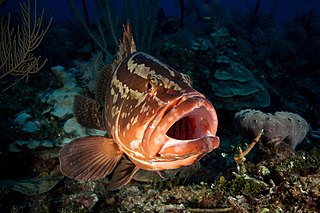
The Nassau grouper is one of the large number of perciform fishes in the family Serranidae commonly referred to as groupers. It is the most important of the groupers for commercial fishery in the West Indies, but has been endangered by overfishing.
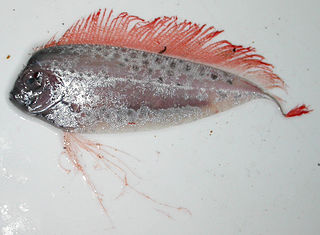
The ribbonfish are any lampriform fishes in the family Trachipteridae. These pelagic fish are named for their slim, ribbon-like appearance. They are rarely seen alive, as they typically live in deep waters, though are not bottom feeders. The perciform fish known as the red bandfish is sometimes referred to as ribbonfish, but it is unrelated to any ribbonfish in the Trachipteridae.

King-of-the-salmon, Trachipterus altivelis, is a species of ribbonfish in the family Trachipteridae. Its common name comes from the legends of the Makah people west of the Strait of Juan de Fuca, which hold that this fish leads the salmon annually to their spawning grounds. Catching or eating king-of-the-salmon was forbidden, as it was feared killing one would stop the salmon run. This myth is reflected by a former specific epithet used for this fish, rex-salmonorum, rex being Latin for "king". The king-of-the-salmon is found in the eastern Pacific Ocean from Alaska to Chile. It is usually found in the open ocean to a depth of 900 meters, though adults sometimes feed on the sea bottom.

Zu cristatus, the scalloped ribbonfish, is a ribbonfish of the family Trachipteridae found circumglobally in all oceans at tropical latitudes, at depths down to 90 m. Its length is up to 118 cm.
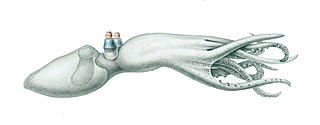
The telescope octopus is a species of pelagic octopus found in tropical and subtropical regions of the Indian and Pacific Oceans.
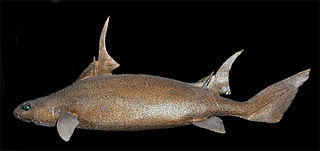
The sailfin roughshark is a species of dogfish shark in the family Oxynotidae, found in the eastern North Atlantic from Scotland to Senegal between latitudes 61°N and 11°N, at depths of between 265 and 720 m. Its length is up to 1.2 m (3.9 ft).

The Pacific bluefin tuna is a predatory species of tuna found widely in the northern Pacific Ocean, but it is migratory and also recorded as a visitor to the south Pacific.
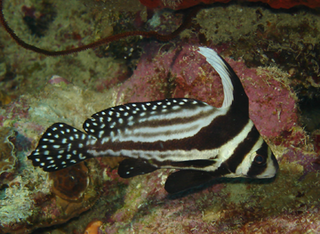
The spotted drum or spotted ribbonfish, is a species of marine ray-finned fish belonging to the family Sciaenidae, the drums and croakers. This species is found in the western Atlantic Ocean.

An endangered species is a species that is very likely to become extinct in the near future, either worldwide or in a particular political jurisdiction. Endangered species may be at risk due to factors such as habitat loss, poaching, and invasive species. The International Union for Conservation of Nature (IUCN) Red List lists the global conservation status of many species, and various other agencies assess the status of species within particular areas. Many nations have laws that protect conservation-reliant species which, for example, forbid hunting, restrict land development, or create protected areas. Some endangered species are the target of extensive conservation efforts such as captive breeding and habitat restoration.
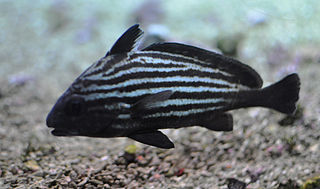
Pareques acuminatus, commonly known as the high-hat, donkeyfish, cubbyu, Steindachner's ribbonfish, streaked ribbonfish, striped ribbonfish or striped drum, is a species of marine ray-finned fish belonging to the genus Pareques in the family Sciaenidae, the drums and croakers. This species is found in the western Atlantic Ocean.
The tapertail, Radiicephalus elongatus, is a species of marine fish found in the central and eastern Atlantic and eastern Pacific. This species grows to 76 cm (30 in) in total length. It is the only known species in the genus Radiicephalus and the family Radiicephalidae.

Trachipterus is a genus of ribbonfishes.

Desmodema polystictum, also called the deal fish, polka-dot ribbonfish, or spotted ribbonfish, is a fish in the family Trachipteridae. It is found near New Zealand, the northwestern Atlantic Ocean, and South Africa. The species became more known when James Douglas Ogilby wrote and published work on the species in 1898.

Trachipterus arcticus is a species of ribbonfish found predominantly in the North Atlantic Ocean, with one report from the Mediterranean Sea. They are rarely encountered by humans due to their deep-sea habitat and the fact that they are of no commercial value. This species is commonly referred to as the dealfish to differentiate it from the nine other ribbonfish species in the family Trachipteridae.

Holothuria (Microthele) fuscogilva, also known as the white teatfish or white teeth, is a species of sea cucumber in the genus Holothuria, subgenus Microthele. The cucumber is found in the tropical waters of the Indo-Pacific ocean. The species is vulnerable to over-exploitation from commercial fishing. It was first formally named by Gustave Cherbonnier in 1980.
Scomberesox simulans, the dwarf saury, is a species of ray-finned fish within the family Scomberesocidae, found in the Atlantic and Indian Ocean. It inhabits tropical and subtropical waters near the surface as a pelagic-oceanic species, migrating as the ocean warms in the spring and summer. It mainly feeds on planktonic organisms. The maximum length recorded was 13 centimeters in length, although the species is most commonly found at 9-10 centimeters in length. It is often confused as the juvenile form of the Atlantic saury.
Zu elongatus, or the taper-tail ribbonfish, is a species of ray-finned fish within the family Trachipteridae. The species distribution is poorly known, and while it likely lives in temperate and tropical waters of all oceans, but has only been encountered in the Atlantic Ocean- off the coasts of Namibia and the western Cape of South Africa- and in the Pacific Ocean off New Zealand. It inhabits mesopelagic waters up to 1200 meters below sea level. Other common names for this species include "scalloped dealfish" and spitsstert-lintvis in Afrikaans.















